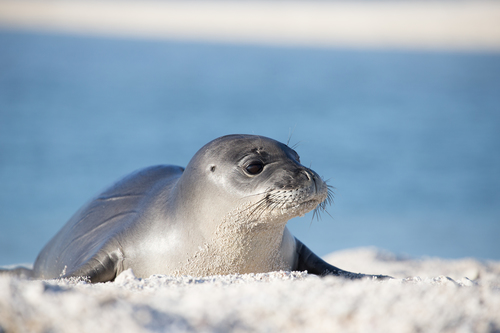
Hawaiian monk seal
The Hawaiian monk seal, Neomonachus schauinslandi, is a rare sight with its sleek gray coat and solitary beach habits. As an apex predator, it helps balance oceanic ecosystems, but faces threats from habitat loss and human activity, making conservation crucial.
30 years
Lifespan
Length: 1.829 - 2.134 m
Size
Grey, White
Color
4 years
Age of Sexual Maturity
1.5 months
Age of Weaning
5 mph
Top Speed
Endangered
Conservation Status
Decreasing
Population Trend
Characteristics
Also known as the Hawaiian monk seal, Neomonachus schauinslandi is an endangered marine mammal native to the Hawaiian Islands. It has a distinctive gray or brown coat, with a lighter belly. These seals are solitary, often found basking on remote beaches, and play a vital role in their marine ecosystem by maintaining healthy fish populations.
Distribution Range of the Hawaiian monk seal
Neomonachus schauinslandi, commonly known as the Hawaiian monk seal, is native to the Hawaiian Islands. This species is predominantly found in the Northwestern Hawaiian Islands, which are part of the Papahānaumokuākea Marine National Monument. These islands include, but are not limited to, Kure Atoll, Midway Atoll, Pearl and Hermes Reef, Lisianski Island, Laysan Island, and French Frigate Shoals.
Hawaiian monk seal's Habitat
Environmental Conditions
The Hawaiian monk seal inhabits subtropical marine environments. It typically resides in coral reefs, atolls, and sandy beaches that provide suitable haul-out areas for resting, molting, and pupping. The climate in these regions is characterized by warm temperatures, with sea surface temperatures ranging from 23°C to 28°C (73°F to 82°F). The area experiences a tropical climate with a wet and dry season, influencing the availability of prey and breeding conditions.
Ecological Niche
The Hawaiian monk seal is a marine predator that primarily feeds on a diverse diet of fish, cephalopods, and crustaceans found within coral reefs and adjacent deep-water habitats. As an apex predator, it plays a crucial role in maintaining the balance of the marine ecosystem. The species has adapted to foraging in relatively shallow waters but can dive to depths of over 500 meters (1,640 feet) in search of food. Due to its reliance on specific marine and coastal environments, the Hawaiian monk seal is vulnerable to habitat disturbances such as human activity, climate change, and competition with other marine species.
Copyright @ Nature Style Limited. All Rights Reserved.
 English
English